Advertisement.
EnchantedLearning.com is a user-supported site.
As a bonus, site members have access to a banner-ad-free version of the site, with print-friendly pages.
Click here to learn more.
(Already a member? Click here.)
 |
Our Solar System |
 |
Solar System Extremes
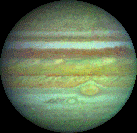 Biggest Planet:
Biggest Planet:
Jupiter. All the other planets in our Solar System could fit inside Jupiter
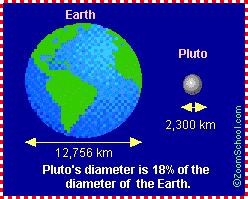 Smallest Planet:
Smallest Planet:
Pluto, a dwarf planet, which is smaller than many moons, including our moon.
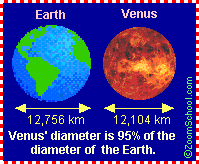 The Planet Closest in Size to the Earth:
The Planet Closest in Size to the Earth:
Venus is about 95% of the Earth's diameter and 82% of the Earth's mass.
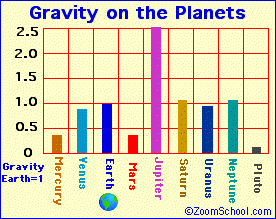 Planet on Which You Would Feel the Heaviest:
Planet on Which You Would Feel the Heaviest:
Jupiter. A 100-pound person would weigh 254 pounds on Jupiter.
 Planet on Which You Would Feel the Lightest:
Planet on Which You Would Feel the Lightest:
Pluto. A 100-pound person would weigh only 9 pounds on the dwarf planet Pluto.
On Mercury and Mars, a 100-pound person would weigh only 38 pounds.
 The Planet that Passes Closest to the Earth:
The Planet that Passes Closest to the Earth:
Venus, which is roughly 38,200,000 km from Earth at its closest approach.
 The Planet with the Longest Year:
The Planet with the Longest Year:
Pluto; a year on Pluto takes 248.5 Earth years.
 The Planet with the Shortest Year:
The Planet with the Shortest Year:
Mercury; a year on Mercury takes only 88 Earth days.
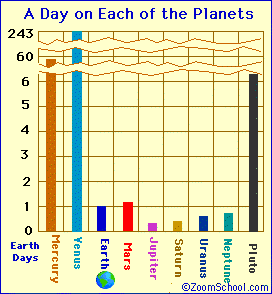 The Planet with the Longest Day:
The Planet with the Longest Day:
Venus; a day on Venus takes 243 Earth days. (A day on Venus is longer than its year; a year on Venus takes only 224.7 Earth days).
The Planet with the Shortest Day:
Jupiter. A day on Jupiter only takes 9.8 Earth hours! When you observe Jupiter from Earth, you can see some of its features change.
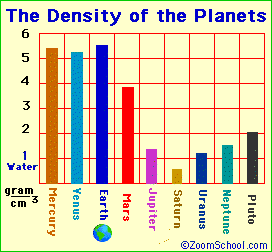 The Densest Planet:
The Densest Planet:
Earth.
The Least-Dense Planet:
Saturn, which would float in water (if you could find a body of water big enough).
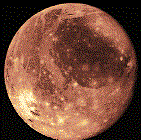 Biggest Moon:
Biggest Moon:
Ganymede, a moon of Jupiter. Ganymede has a diameter of 5,262 km (3,280 miles), bigger than the planets Pluto or Mercury and about a third of the Earth's diameter.

Triton, the biggest moon of Neptune. |
The Only Two Moons With Atmospheres:
Titan, a moon of Saturn and Triton, a moon of Neptune.
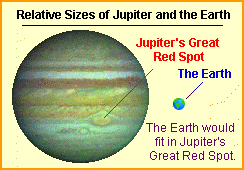
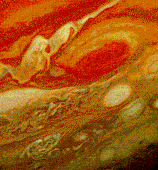 Biggest Storm:
Biggest Storm:
The Great Red Spot on Jupiter, which is a storm about 17,000 miles (28,000 km) long and 9,000 miles (14,000 km). It is so big that two Earths could fit in it. This giant storm has lasted hundreds of years so far.
 Fastest Winds:
Fastest Winds:
On the surface of Neptune. These winds are up to 1,500 miles per hour (2,400 km per hour).
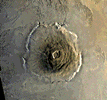 Biggest Volcano:
Biggest Volcano:
Olympus Mons, the largest volcano (now extinct) in the Solar System is on Mars. It is 17 miles (27 km) tall and over 320 miles (520 km) across. It erupted an estimated 20-200 million years ago.
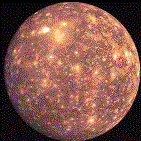 Largest Impact Crater:
Largest Impact Crater:
Valhalla, on Callisto, a moon of Jupiter. Valhalla has a bright patch
600 km across and rings that go out to almost 3000 km.
 The Hottest Planet:
The Hottest Planet:
Venus, which has temperatures up to 480°C.
 The Coldest Planet:
The Coldest Planet:
Pluto, which has temperatures down to -238°C.
 Coldest Measured Object:
Coldest Measured Object:
Triton, a moon of the planet Neptune.
 Smoothest Object:
Smoothest Object:
Europa, a large moon of Jupiter, is the smoothest object in the solar system.
 Most Eccentric orbit (excluding comets):
Most Eccentric orbit (excluding comets):
Nereid, a moon of the planet Neptune.
 Orbit Most Inclined From the Ecliptic (excluding comets):
Orbit Most Inclined From the Ecliptic (excluding comets):
Pluto, whose orbit is inclined 17.15 degrees from the ecliptic.
 Most Tilted Rotational Axis:
Most Tilted Rotational Axis:
Uranus, whose axis is tilted 97.9 degrees from perpendicular to the plane of the ecliptic.
 Most Oblate (Flattened) Planet:
Most Oblate (Flattened) Planet:
Saturn is the most oblate planet in our Solar System; the difference between its equatorial and polar diameters is almost 10%.
 Planet Farthest From the Sun:
Planet Farthest From the Sun:
Usually Pluto is the farthest planet from the Sun, but sometimes (during a 20-year period out of every 248 Earth years) Neptune is the farthest.
Enchanted Learning®
Over 35,000 Web Pages
Sample Pages for Prospective Subscribers, or click below
Click to read our Privacy Policy
E-mail
Enchanted Learning Search
|
Search the Enchanted Learning website for:
|
Advertisement.
Advertisement.
Copyright ©1998-2018
EnchantedLearning.com ------ How to cite a web page


